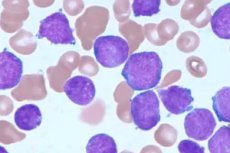New publications
A leukemia diet exists
Last reviewed: 02.07.2025

All iLive content is medically reviewed or fact checked to ensure as much factual accuracy as possible.
We have strict sourcing guidelines and only link to reputable media sites, academic research institutions and, whenever possible, medically peer reviewed studies. Note that the numbers in parentheses ([1], [2], etc.) are clickable links to these studies.
If you feel that any of our content is inaccurate, out-of-date, or otherwise questionable, please select it and press Ctrl + Enter.

If the intake of the amino acid valine into the body is stopped, the course of acute T-cell lymphoblastic leukemia is almost completely blocked, which was observed in an experiment conducted on rodents.
The study of protein amino acids is a popular task for scientists around the world. In a recent study, scientists from New York University were able to discover an important property of valine, an aliphatic α-amino acid, one of twenty proteinogenic amino acids that are part of many known proteins. The specialists were studying the structures of T-cell lymphoblastic leukemia: this is a common malignant pathology that mainly affects children and young people. The biological and chemical characteristics of the acute disease were studied. And the immediate goal of the scientists was to clarify trophic processes and determine substances that are especially important for the development of the malignant process.
During the experimental work, malignant structures were transplanted from humans to modified rodents. Subsequently, the mice predictably developed leukemia. As a result, it was discovered that if the rodents adhered to a valine-free diet, then for three weeks the progression of the disease was completely blocked, and the number of malignant cells in the circulatory system decreased by at least 50%, or they disappeared altogether. But when valine was re-used with food, leukemia resumed.
According to the basic molecular processes, acute T-cell lymphoblastic leukemia is dependent on the multifunctional NOTCH1 gene. Malignant changes in the gene increase the levels of tRNA (transport ribonucleic acid, which ensures the interaction of the ribosome, amino acid and messenger RNA during translation). It is tRNA that transports valine to protein-synthesizing mechanisms.
Each amino acid has its own tRNA, which holds a particular amino acid and combines with a triplex combination of messenger RNA. Without transport RNA, protein synthesis cannot occur. Malignant structures of leukemia require a large amount of mitochondrial protein, and for its production in the required amount, valine is needed - in the appropriate volume. Therefore, malignant cells are in dire need of NOTCH1 mutations that activate the production of valine tRNA. To affect leukemic structures, it is enough to reduce the number of valine transport RNAs, or reduce the level of valine itself, which will break the transport chain.
It is quite possible that a similar scheme can be applied to other types of malignant pathologies. For now, scientists can only talk about leukemia: with a high degree of probability, the effectiveness of treatment can be supplemented and potentiated if the patient adheres to a diet that involves limiting the intake of valine into the body. By the way, complete exclusion of valine is not recommended, since a deficiency of the amino acid adversely affects the condition of the brain and muscles.
Scientists published full information on the page of the journal Nature
